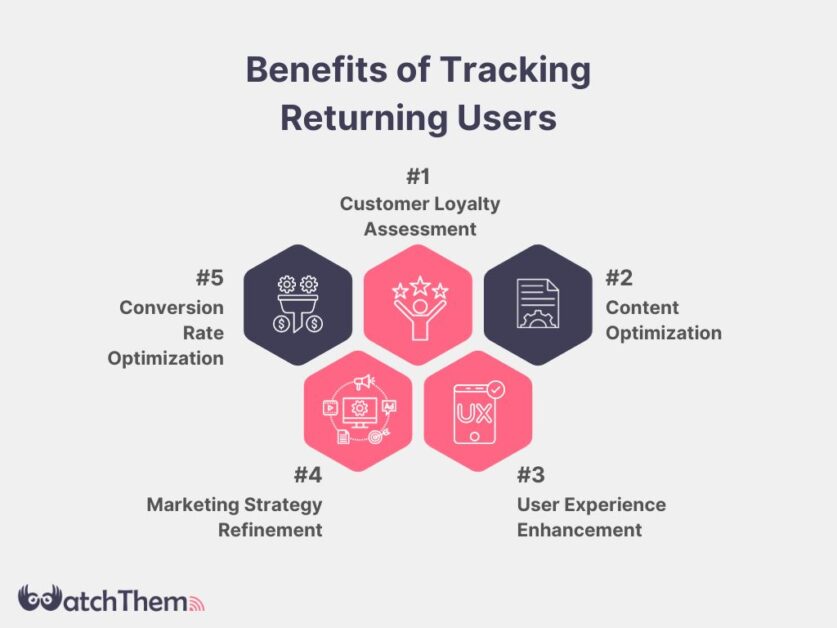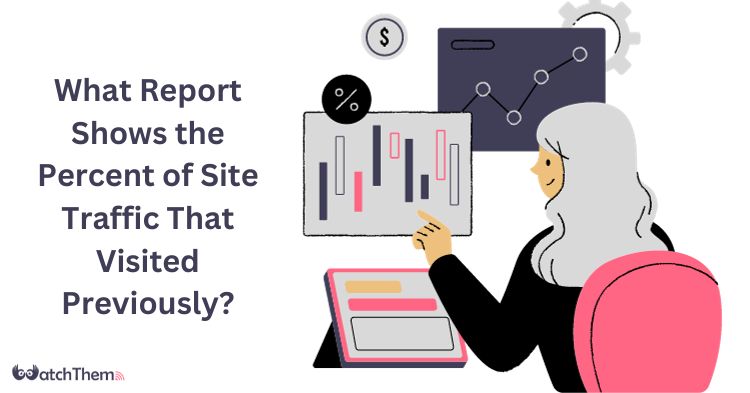Page Contents
Visitors are the heart of any website, and keeping them happy is every business’s dream. However, this goal won’t be possible without a close inspection of their behavior. At some point along this journey, a curious mind might ponder:’ What report shows the percent of site traffic that visited previously?’. Well, that’s precisely what we’ll delve into in this article.
A successful website owner knows the importance of customer retention metrics and how they can impact the overall performance of a website. That’s why it’s important to know what report shows the percent of site traffic that visited previously. It will allow you to optimize user experience, discover areas for improvement, and form a long-lasting relationship with your visitors.
In this guide, we’re going to address any questions you might have regarding website traffic and user retention. This resource will be particularly valuable if you’re preparing for the Google Analytics individual qualification exam. So, without further ado, let’s get down to business!
Understanding Website Traffic
Before diving into questions such as ‘What report shows the percent of site traffic that visited previously?’, it’s important to know what site traffic is and where it comes from.
Website traffic refers to the number of visitors who access or view a website. It is a crucial metric for understanding the popularity and reach of a website. Before delving into specific reports, let’s take a moment to understand the different sources of website traffic:
- Direct Traffic: Visitors who come directly to your website by typing the URL into their browser or using a bookmark.
- Organic Search Traffic: Visitors who find your website through search engines like Google, Bing, or Yahoo.
- Referral Traffic: Visitors who come to your site by clicking on a link from another website.
- Social Media Traffic: Visitors who arrive at your site through social media platforms such as Facebook, Twitter, or Instagram.
- Paid Traffic: Visitors who land on your website through paid advertising, such as Google Ads or social media ads.
Understanding the sources of website traffic helps you identify which channels are driving the most visitors to your site. Once you have a grasp of overall traffic sources, you can then focus on understanding the behavior of repeat visitors, which brings us to the question: ‘What report shows the percentage of traffic that previously visited a website?’. Keep scrolling to find out!
What Report Shows the Percent of Site Traffic That Visited Previously?
To answer the question, we turn to a fundamental tool for website analytics – Google Analytics. The specific report you’re looking for is the New vs Returning report. This insightful feature allows you to understand the individual user journey as it provides detailed information about their interactions with your website.
The ‘New vs Returning report’ in Google Analytics is a powerful resource for gaining insights into the composition of your website’s audience. This report essentially categorizes your site visitors into two main groups: new users and returning users.
- New Users: This category includes visitors who are accessing your website for the first time during the specified reporting period. These individuals may have discovered your site through various channels such as search engines, social media, or external links.
Analyzing the behavior of new users is crucial for understanding how well your website attracts and engages with a fresh audience.
- Returning Users: On the other hand, returning users are those who have visited your website before and are coming back for more. This group often consists of individuals who found value in your content or services during their initial visit.
Monitoring the behavior of returning users is vital for gauging the effectiveness of your content, user experience, and overall site retention.
Now, to specifically address the question about this website traffic report, focus on the percentage of returning users in the ‘New vs Returning report.’ This percentage represents the proportion of your overall site traffic that consists of individuals who have visited your website before.
A high percentage of returning users generally indicates a strong brand or content appeal, while a low percentage may suggest challenges in retaining visitors or attracting new ones.
Locating the ‘New vs Returning Report’ in Google Analytics
To find this report, follow these steps:
- log in to your Google Analytics account.
- Navigate to the desired property and view.
- In the left-hand menu, go to ‘Audience.’
- Click on ‘Behavior.’
- Select ‘New vs Returning.’.
By regularly monitoring this report, you can make informed decisions to optimize your conversion rate. Ultimately, you’ll be able to enhance the overall user experience and maximize the impact of your online presence.
Now that you know the answer to ‘Which report helps you determine the percent of your site traffic that has visited previously?’, it’s time to see why tracking returning users is crucial for all businesses.
Benefits of Tracking Returning Users
As we mentioned earlier, tracking returning users provides valuable insights that can significantly benefit your business. Here are some key advantages:


#1 Customer Loyalty Assessment
By monitoring returning users, you can better understand the loyalty of your audience. A higher number of returning visitors suggests that your website successfully retains its audience, indicating customer satisfaction and loyalty.
#2 Content Optimization
Analyzing the behavior of returning users helps you identify which content resonates with your audience. When you know what specific pages or topics are attracting repeat visits, you can tailor your content strategy to meet the preferences and interests of your core audience.
#3 User Experience Enhancement
Returning users provide a unique opportunity to evaluate the effectiveness of your website’s user experience. If visitors are returning, it shows that they find value in your site.
#4 Marketing Strategy Refinement
Knowing the percentage of returning users helps refine your marketing strategies. For example, if your organic search traffic contributes significantly to returning users, you may want to invest more in SEO efforts.
On the other hand, if social media is a primary source, you might focus on strengthening your social media marketing initiatives. This approach allows you to allocate resources where they are most effective.
#5 Conversion Rate Optimization
Returning users are more likely to convert compared to new visitors. By tracking their behavior, you can identify patterns that lead to conversions. Understanding the elements that drive returning users to take specific actions enables you to optimize your website for increased conversion rates, whether it’s making a purchase, signing up for a newsletter, or engaging with your content.
How to Increase the Percentage of Returning Users
Increasing the percentage of returning users is a strategic goal that can positively impact your website’s success. So, here are some effective strategies to enhance customer retention and boost the percentage of returning users:
#1 Provide High-Quality Content
Ensure that your website consistently delivers valuable, relevant, and engaging content. This can include informative articles, entertaining videos, or interactive features.
#2 User-Friendly Website Design
Optimize your website’s user interface and experience. A well-designed and easy-to-navigate site encourages visitors to return. Pay attention to page load times, mobile responsiveness, and overall accessibility.
#3 Personalized User Experience
Leverage user data to personalize the browsing experience. Implement features such as personalized recommendations, tailored content suggestions, and user-specific notifications to enhance user engagement.
#4 Social Media Engagement
Maintain an active presence on social media platforms. Share your content, interact with your audience, and create a sense of community. Encourage users to follow your social accounts for updates and discussions.
#5 Reward Loyalty
Introduce loyalty programs or exclusive perks for returning users. Rewards can include discounts, early access to new content, or special promotions. These incentives encourage users to revisit your site and eventually, increase the percentage of returning visitors.
#6 Responsive Customer Support
Offer responsive customer support to address any issues or concerns promptly. A positive customer service experience can contribute significantly to customer satisfaction and loyalty.
Combining these strategies and consistently monitoring the ‘New vs Returning’ report in Google Analytics allows you to develop a comprehensive approach to improve customer retention and boost the percentage of returning users on your website.
FAQs About What Report Shows the Percent of Site Traffic That Visited Previously?
Before we finish this article, we’re going to answer some frequently asked questions so that you can gain a comprehensive understanding of the topic and address any lingering uncertainties you may have:
Q1. What Is Site Traffic Report?
A site traffic report is a summary of data that tracks and analyzes user activity on a website. It includes metrics like visitor count, pageviews, bounce rate, and more, offering insights into how users interact with the site. This information helps website owners make informed decisions to improve performance and user experience.
Q2. What Is a Returning Visitor?
A returning visitor refers to someone who has previously visited a particular website or online platform and has returned to it for another visit. In the context of web analytics and website statistics, tracking returning visitors is important for understanding user behavior and engagement.
What Report Shows the Percent of Site Traffic That Visited Previously?: Final Words
Understanding the dynamics of site traffic is essential for any website owner aiming to enhance user experience and build lasting relationships with visitors. The key report that reveals the percentage of site traffic that visited previously is the ‘New vs Returning report’ in Google Analytics.
Analyzing this report, which categorizes users into new and returning, allows businesses to gain valuable insights into customer loyalty and user experience.

